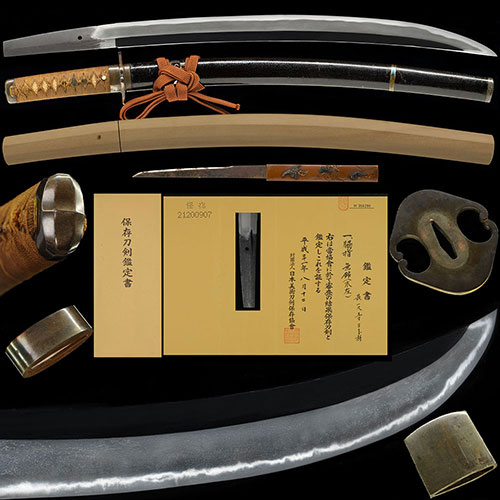
末左 脇差 Suesa Wakizashi
No.682144末左 南北朝時代 身幅3.2cm豪壮な薙刀直し 黒く精良な地鉄に映り立ち金筋沸筋掛る名品 総四分一金具拵付 一尺五寸四分Suesa Nanbokucho period, Wide 3.2cm, magnificent Naginata-Naoshi, Blackish clear Jigane, Utsuritachi, Kinsuji, Niesuji-kakaru, a masterpiece, with Full Shibuichi metal fittings 46.6cm
ご成約Sold
- 極めKiwame
- 末左Suesa
- 登録証Registration
- 兵庫県 Hyogo 平成18年5月18日 5/18/18(Heisei)
- 時代Period
- 南北朝時代Nanbokucho period
- 法量Size
-
刃長 46.6cm (一尺五寸四分) 反り 1.2cm
元幅 3.1cm 先幅 3.2cm 元重 0.20cm 鎬厚 0.69cm 茎長 14.0cm 重量 428gHachou 46.6cm (一尺五寸四分) Sori 1.2cm
Moto-Haba 3.1cm Saki-Haba 3.2cm Moto-Kasane 0.20cm Shinogi-Thikess 0.69cm Nakago-Chou 14.0cm Weight 428g - 国Country
- 筑前Chikuzen
- 姿Shape
- 薙刀直し造、庵棟、身幅広く、先反りつく。Naginata-Naoshi-tsukuri, Iorimune, Wide Mihaba, Sakisoritsuku.
- 鍛Kitae
- 小板目肌つみ、杢目肌交じり、地沸微塵に厚くつき、地景細かく入り、映り立つ。Small-Itamehada-tsumi, Mixed Mokumehada, Jinie entered fin and thick, Chikei entered finely, Utsuritatsu.
- 刃文Hamon
- のたれて、小互の目交じり、食い違い・二十刃掛かり、足・葉よく入り、小沸よくつき、金筋・沸筋・砂流し掛り、匂口明るい。Notarete, Mixed Small-gunome, Kuichigai, Nijuba-kakari, There are Ashi and You frequently, Small-Nie entered frequently, Kinsuji, Niesuji and Sunagashi-kakari, Nioikuchi is bright.
- 帽子Boushi
- 乱れ込んで小丸、深く返る。Midarekonde-Komaru, Deep return(Fukaku-kaeru)
- 茎Nakago
- 大磨上、先切、鑢目勝手下り、目釘孔一。Ohsuriage, Sakikiri, Yasurimekattesagari, Mekugiana is one(1)
- ハバキHabaki
- 四分一地一重。Single Shibuichiji
- 拵Sword mounitings
- 四分一総金具黒魚子塗鞘拵[江戸時代]
法量
長66.2cm 反2.5cm
説明
総金具 四分一磨地、 目貫 四分一地梅鉢紋。 小柄 素銅地鶴亀松図赤銅末紋。
Shibuichi Full metal fittings Kuro(Black)-nanako Nurisaya Koshirae(Edo period)
Length: 66.2cm
Sori:2.5cm
Full metal fittings: Shibuichi Migakiji
Menuki: Shibuichi Umebachimon(Plum-shaped bowl)
Koduka: Suakaji Tsurukame(crane and turtle) Matsuzu(pine) Syakudou Suemon - 説明Drscription
- 筑前国左文字は、大左と通称され、実阿の子と伝え、銘文の左は、左衛門三郎の略という。相州正宗十哲の一人に数えられ、それまでの古典的な九州物の作域から大いに脱皮し、地刃共に明るく冴え、地景や金筋の目立つ新作風を確立した。左一門は、南北朝期に大いに栄えたが、大左の子と伝える貞吉・安吉を始め弘行・国弘などがいて、これら左一門を末左と呼称する。この刀は、身幅広い豪壮な姿の薙刀直しで、小板目肌つみ、杢目交じり、地沸が微塵に厚くつき、映り立ち、地景細かく入り、黒みがかった精良な地鉄に、のたれに、小互の目交じり、足・葉よく入り、小沸つき、金筋・沸筋・砂流し掛るなど働き豊かで、匂口明るい名品である。Chikuzennokuni Samonji is commonly known as Ohsa and is said to be a child of Jitsua, and the inscription Sa is an abbreviation for Saemon saburou. He was one of Sousyu Masamunejittetsu, and he was a big break from the classic Kyusyu production area, and he was bright and clear with Jiba, establishing a prominent new style of Chikei and Kinsuji. The only existing Tachi in existence is the national treasure "Kousestsu Samonji", but there are relatively many examples of Tantou. The Sa family prospered greatly during the Nanbokuchou period, but there are Sadayoshi, Yasuyoshi, Hiroyuki, Kunihiro, etc. who are said to be children of Ohsa, and these Sa families are called Suesa.
This sword has wide Mihaba, magnificent Naginata-naoshi, Small-Itamehada-tsumi, Mixed Mokume, Jinie entered fine and thick, Utsuritachi, Chikei entered finely, Blackish clear Jigane, Notare, Mixed Small-Gunome, There are Ashi and You frequently, Small-Nie-tsuki, Kinsuji, Niesuji and Sunagashi-kakaru, It works good in sword, Nioikuchi is bright and clear, an excellent sword.



